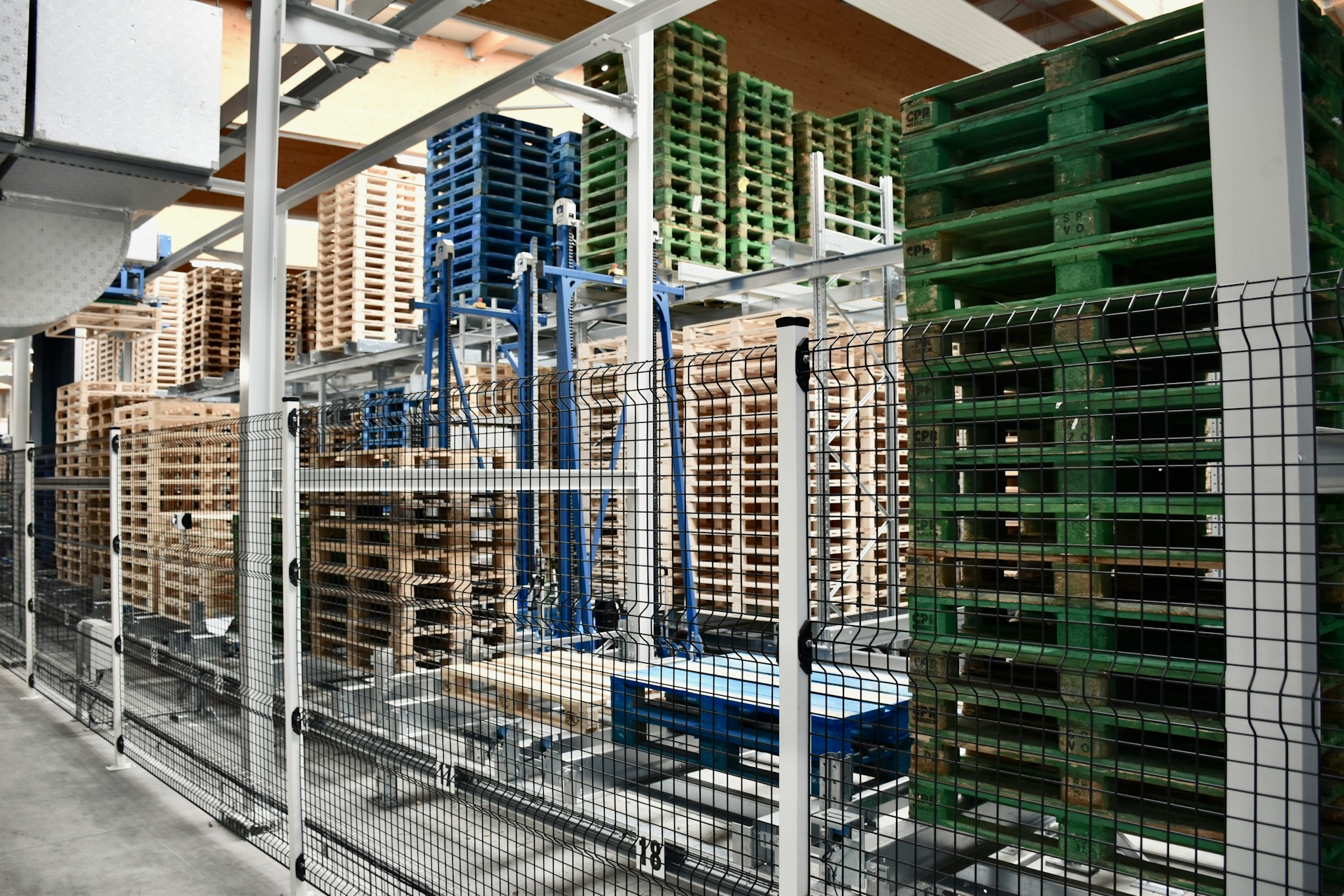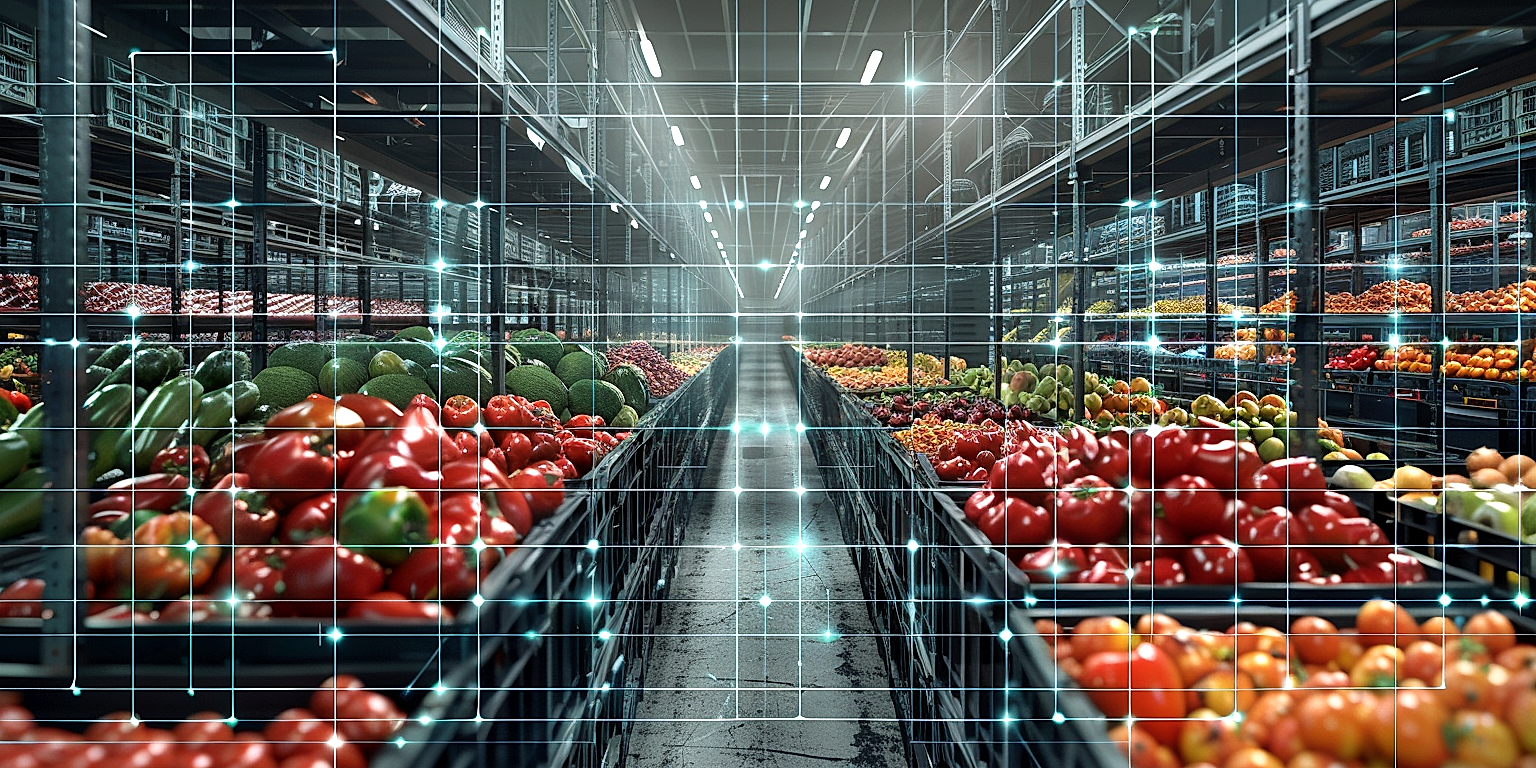In the complex world of produce distribution, warehouse management is a critical factor that often dictates the level of success for a business.
It plays an essential role in ensuring fresh fruit and vegetables are meticulously stored, carefully sorted, and swiftly dispatched.
A tightly run warehouse can mean the difference between profit and loss, customer satisfaction and disappointment.
However, mastery of this aspect requires a clear understanding of its core elements.
In this informative piece, we delve into the vital aspects of this operation, providing insights and tips for enhanced productivity and efficiency.
The information herein unveils valuable strategies that can be instrumental in strengthening your distribution processes and ultimately, fortify your bottom line.
Contents
- Warehouse Management Essentials For Produce Distribution
- 1. Efficient Inventory Control and Tracking
- 2. Proper Temperature and Humidity Controls
- 3. Fast Rotation and Dispatch Procedures
- 4. Regular Maintenance and Cleaning Schedules
- 5. Use of Suitable Storage Solutions
- 6. Compliance with Safety and Health Regulations
- 7. Training for warehouse personnel
- 8. System for Managing Overripe or Damaged Goods
- 9. Proper Layout for Easy Access and Movement
- 10. Implementation of Automation and Digital Solutions
- The Bottom Line
Warehouse Management Essentials For Produce Distribution
1. Efficient Inventory Control and Tracking
Having an efficient inventory control and tracking system is one of the essentials in warehouse management for produce distribution.
A robust tracking system can ensure no product gets lost in the vast space of the warehouse.
By means of efficient inventory control, warehouse managers can make informed decisions about the stock level requirements and inventory investments.
Accurate inventory quantities are crucial in preventing overstocking or understocking which can lead to unnecessary costs and loss of sales.
It is equally important to track the location of goods within the warehouse, as this reduces the time taken to locate and move products thus ensuring smoother operations.
Efficient inventory control and tracking system can also help to prioritize the stock rotation, allowing products with sooner expiration dates to be dispatched first, reducing wastage.
Technological advancement has allowed for more efficient inventory control through the use of tools like barcoding, RFID (Radio Frequency Identification), and WMS (Warehouse Management System).
The use of such tools accelerates data collection, improves accuracy, and reduces human error which is common in manual data entry.
Furthermore, to avoid produce spoilage and to ensure the quality of goods, it’s critical to have real-time visibility into inventory and supply chain operations.
Instant updates about the inventory conditions can help to take immediate corrective actions, if needed, guaranteeing the freshness and quality of the produce.
By maintaining precise control over the inventory, a warehouse can run at maximum efficiency, saving time and money in the process.
An optimized warehouse operation eventually leads to increased customer satisfaction and retention.
However, implementing an efficient inventory control and tracking system isn’t a one-time thing, it requires continuous monitoring, evaluation, and updating to ensure it remains effective.
Thus, warehouse managers should invest time and resources in training their staff on how to effectively implement and use these inventory control and tracking tools.
Efficient inventory control and tracking is, therefore, more than just counting products, it involves managing stock levels, prioritizing stock rotation, ensuring the freshness and quality of the produce, and in the process, maximizing overall warehouse efficiency.
2. Proper Temperature and Humidity Controls
In the realm of produce distribution, maintaining proper temperature in your warehouse is of utmost importance.
When fruits and vegetables are not stored at their correct temperature, their shelf life diminishes exponentially.
Failing to maintain the correct temperature can result in loss of product due to spoilage.
Temperature monitoring systems in the warehouse can help maintain the optimal temperature required for different produce.
These systems can automatically adjust the warehouse temperature to adapt to changes in weather or to cater to different types of fruits and vegetables being stored.
In addition to temperature controls, humidity control also plays a pivotal role in preserving the freshness of fruits and vegetables.
Produce like leafy greens require a higher level of humidity to stay fresh compared to other fruits and vegetables.
Integrated temperature and humidity control systems can regulate both these factors ensuring produce stays fresh and marketable for a longer time.
Advanced control systems also provide real-time monitoring and alerts in case of any outlier in the predictable temperature and humidity range.
For instance, if the temperature in a certain region of the warehouse goes beyond the allocated range, the system can alert the management to take preventive measures immediately.
Tracking and maintaining temperature and humidity becomes a quality control procedure that is crucial in the industry of produce distribution.
Since every produce item has its own ideal temperature and humidity range, it demands individualized storage procedures and directives that are adhered to strictly.
Technology plays a key role in these procedures, allowing for automated regulation and monitoring.
With these systems in place, warehouse operation becomes more efficient, ensuring that the quality of the produce is never compromised.
Therefore, implementing proper temperature and humidity controls is not just an essential item in warehouse management but is also a prerequisite for maintaining the optimal freshness and quality of the distributed produce.
3. Fast Rotation and Dispatch Procedures
Proper warehouse management for produce distribution requires efficient practices, particularly in the area of fast rotation and dispatch procedures.
In managing perishable goods such as produce, one must understand that time is of the essence as perishability is a primary concern.
An essential practice is the First-In, First-Out (FIFO) principle, which ensures that the first items received are the first to be dispatched.
This method aids in preventing product spoilage as it doesn’t let any product stay too long in the warehouse.
Today’s warehouse management technology offers advanced solutions that can optimize the rotation and dispatch process.
Software can track and manage inventory, helping the warehouse staff to find the oldest batches for delivery.
Efficient tech-enabled dispatch and rotation procedures significantly reduce the likelihood of products becoming overripe or damaged before dispatch.
In addition, a logistics software can help manage dispatch schedules, ensuring fast and efficient delivery of produce to retailers and consumers.
The software can also help dispatch personnel to prepare for shipping, arranging items in the right order for speedy loading and unloading at their destination.
Dispatch procedures should be reviewed regularly to ensure they are appropriately time-responsive and proactive.
Staff should retrieve the products from the warehouse in a swift and organized manner to avoid unnecessary delays.
Simultaneously, delivery routes and schedules should be optimized, with a consideration for factors such as traffic, distance, and truck capacity.
Such measures are crucial in ensuring that the fresh produce arrives at the retail points as fresh as possible.
Therefore, fast rotation and dispatch procedures contribute significantly to maintaining the quality and freshness of the produce, which eventually maximizes customer satisfaction.
However, while speed is important in shipment and delivery, it should never compromise the safety or quality of the products being delivered.
Ultimately, the goal is to have an efficient system that ensures fresh produce is moved as quickly and safely as possible from warehouses to retail points.
4. Regular Maintenance and Cleaning Schedules
Maintaining an efficient warehouse essentially demands adherence to regular cleaning and maintenance schedules.
Maintenance not only involves repair and refurbishment of equipment used in the warehouse but also requires attention towards cleanliness and safety issues related to the area used for storing produce.
Regular cleaning helps in eliminating potential risks associated with spoilage and contamination of produce.
The maintenance schedule should be based on the nature of produce being stored in the warehouse and the types of machines and tools used for handling them.
Maintenance and repair activities should be performed outside the operational hours of the warehouse to minimize disruption.
Moreover, a comprehensive preventive maintenance plan that includes regular checks and inspections needs to be in place to ensure equipment is operating at optimal levels and any issues can be addressed before they escalate.
Top priority should be given on avoiding cross-contamination during cleaning activities by using appropriate sanitizing agents and tools.
It is integral to keep track of all the cleaning and maintenance activities to ensure compliance with quality standards set by health and safety regulations.
Maintaining a logbook or digital record for evidence of performed maintenance tasks can be extremely helpful.
Developing standard operating procedures (SOPs) for maintaining and cleaning can boost efficiency even further.
Adequate training should be provided to the warehouse personnel on how to execute these SOPs effectively.
Using automation solutions for scheduling, tracking, and executing maintenance tasks can also provide efficiency gains.
Maintenance and cleaning activities are considered as a form of investment to ensure the longevity and efficiency of warehouse operations.
Proper maintenance and cleanliness can also enhance the image of a warehouse and foster trust among clients.
In essence, regular maintenance and cleaning regimes should be an integral part of the warehousing management to promote operational efficiency and safety while complying with health regulations.
5. Use of Suitable Storage Solutions
As a core component of effective warehouse management in produce distribution, utilizing suitable storage solutions is essential.
Effective storage solutions optimize warehouse space, enhance operational efficiency, and ultimately safeguard the quality of the produce.
The type of produce being stored largely dictates the choice of storage solutions.
For instance, delicate produce such as leafy greens might require different storage solutions than hardier fruits like oranges or apples.
In addition, the quantity and frequency of produce passing through the warehouse also significantly influence the type of storage system selected.
It is crucial that the storage solutions are flexible to accommodate variations in produce volume and variety.
This flexibility allows seasonality factors to be considered and thus, contributes to the efficiency and productivity of the warehouse.
Another key consideration when selecting suitable storage solutions is the shelf life of the produce.
The refrigeration capabilities of the units must be able to maintain the produce at the desired temperatures to help extend its shelf life.
Conversely, some types of produce might require specially designed storage solutions that allow for adequate aeration.
These produce types might need crates or slatted shelves that enable air circulation to prevent rot and deterioration.
Moreover, the storage solutions should be easy to clean and maintain.
High hygiene standards are non-negotiable in a produce distribution warehouse to prevent cross-contamination and the spread of diseases.
Therefore, the selected storage solutions must be made from materials that are resistant to pests and fungi and easy to clean.
Furthermore, well-structured and organized storage solutions facilitate efficient produce tracking and fast inventory rotation.
Thus, the storage design should promote excellent visibility and accessibility of the produce.
Digital solutions, such as warehouse management systems (WMS), can be integrated with the storage solutions to further optimize inventory management and tracking.
All these considerations play a significant role in ensuring that the storage solutions applied are suitable for a produce distribution warehouse.
Regular assessment of storage solutions need to be conducted to ensure they are effective and meet the ever-changing needs of the business effectively.
6. Compliance with Safety and Health Regulations
In facilitating proper warehouse management for produce distribution, adherence to safety and health regulations is unequivocally crucial.
A warehouse houses various potential hazards that need to be handled with care and vigilance, making it fundamental to ensure compliance with safety measures meticulously.
The health and safety regulations applicable to warehouses can change depending on the specific country or region, hence it is imperative for warehouse managers to stay updated with current regulations and standards.
Safety compliance is not only about avoiding penalties and lawsuits but is more significantly about protecting the lives and health of the workers who make the operations possible.
Given the perishable nature of the goods, the rules for food safety and hygiene become an additional layer of regulations specific to produce warehouses.
Ensuring routine safety audits and inspections forms a vital part of this regulatory compliance.
Maintaining =clear documentation of these audits allows for tangible proof of compliance and aids in identifying areas in need of improvement.
To enable this, safety personnel should be adequately trained to identify potential risks and rectify them.
Providing workers with appropriate personal protective equipment (PPE), proper training on how to use it, and continuously reinforcing its importance is paramount.
Another critical aspect of safety regulations is the management and disposal of waste products.
It becomes crucial to ensure all waste is handled following health codes and reducing contamination risk, especially considering the nature of the produce.
The warehouse must also have emergency plans and procedures in place for situations like fire, spillage, or other disasters.
Such plans should be well communicated with all workers, and drills should be conducted frequently to ensure each worker is familiar with the procedures.
The warehouse should ensure provisions for first aid and also have adequately trained personnel for administering it.
Apart from these procedural regulations, physical safety measures like proper ventilation, sufficient lighting, clean and clutter-free working environments, should be maintained as these directly influence the overall health conditions in the warehouse.
Adhering to these safety and health regulations play a significant role in safeguarding the personnel, the produce, and ensuring the seamless flow of warehouse operations.
7. Training for warehouse personnel
For every warehouse, especially those focused on produce distribution, the skills, knowledge, and competence of the workforce is an indispensable component of successful operation.
Training for warehouse personnel is not just about teaching basic skill sets, but it’s also about improving efficient and productive performance in the workplace.
An effective training program ensures that staff understand the dynamics of managing perishable goods and are prepared to handle any situation that may arise.
Employees who are well-equipped with adequate knowledge and right skills can help in maintaining superior warehouse operations and significantly reducing errors and wastage.
Training must also focus on creating a safe and regulatory-compliant work environment.
Staff members should be thoroughly trained in the protocols of handling produce, including implementing proper storage measures, maintaining appropriate temperature levels, and quickly addressing issues related to overripe or damaged goods.
Additionally, implementing a strong training program also helps in decreasing employee turnover rates.
It not only boosts employee productivity but also improves their morale, motivation and job satisfaction levels, which in turn fuel enhanced performance and long-term commitment.
There are various strategies that can be adopted to implement effective training. These include on-the-job training, mentoring programs, software training or even external training programs.
One of the key components of training warehouse staff is the understanding and implementation of advanced warehousing technologies, such as inventory management systems and automation solutions.
Having a tech-savvy team can drastically improve the warehouse processes, from efficient inventory control and tracking to fast rotation and dispatch procedures.
Moreover, well-trained personnel are endowed with the capability of adjusting to the constant changes and advancements in the field of warehouse management, enabling an organization to stay ahead in this competitive domain.
Periodic assessment and updates of the training program is an important aspect to keep the warehouse staff up-to-date with the continuous changes in warehouse operations and technologies.
Robust training strategies not only enhance the competence and productivity of the staff, but also contribute significantly to the overall efficiency, excellence and profitability of the warehouse.
It is therefore clear that effective staff training is a critical factor for the success of warehouse management in the arena of produce distribution.
8. System for Managing Overripe or Damaged Goods
It is fundamental for the warehouse’s operations to have a proper system for managing overripe or damaged goods, particularly in the context of produce distribution where these can be common occurrences.
Constant vigilance and frequent inspections should be part of the warehouse’s protocol to identify any perishable goods that have gone overripe or suffered damage.
Prompt identification ensures a faster turnover avoiding further deterioration which could negatively influence other produce stored nearby.
Once identified, these goods have to be removed immediately from the common inventory to prevent contaminations or potential spread of disease, especially when dealing with produce.
Produce that can still be used despite being overripe or slightly damaged may be redirected to other channels, preventing total loss and demonstrating a commitment towards waste reduction strategies.
A robust tracking system can make this task easier by providing relevant data about the goods in stock including their shelf life, expected expiry, and condition.
This information can be leveraged to rotate the goods optimally and make inventory decisions that minimize money loss.
Workers, in particular, need to be trained and made responsible for immediately responding to any spotted overripe or damaged produce.
They should also be encouraged to take preventive measures, such as proper handling of goods to prevent damages during stocking or dispatching.
Effective communication channels should be established within the team to report damages right when they occur so that quick actions can be initiated.
Having a system that can automatically alert the management about potential overripening based on predictive analytics can be highly beneficial in the long run.
It is crucial to note that dealing with overripe or damaged goods involves placating the customers’ dissatisfaction.
A sound return and refund policy are deemed necessary to ensure a smooth and effortless transaction experience for the customers.
Going a step further, warehouses could collaborate with the local community and contribute the overripe products to food banks or NGOs, setting an excellent example of corporate social responsibility.
The whole process of managing overripe or damaged goods should also be supported with transparent documentation that records relevant data, ensuring traceability and accountability.
9. Proper Layout for Easy Access and Movement
The functional design and layout of a warehouse considerably impact its efficacy and productivity.
An accurate warehouse layout is not only essential for storage but also for smooth navigation and efficient workflow.
In the realm of produce distribution, it’s particularly crucial due to the perishability of the products involved.
Thus, a well-planned layout is a non-negotiable prerequisite to ensure that the labyrinth of pallets, crates, boxes, and forklifts operate like clockwork.
Good warehouse layout facilitates easier access and movement for employees, thereby, minimizing time wastage and improving goods’ shelf-life.
Efficient space utilization is another significant advantage of proper warehouse layout.
It is the need of the hour to devise a warehouse layout that cater to the unique requirements of perishable goods.
This could involve designing and allotting specific zones for dissimilar kinds of produce, depending upon their size, shelf-life, and temperature requirements.
Signage and labeling can significantly boost navigation within a warehouse, particularly in large warehouses where saving time is of utmost importance.
Another important aspect includes designing pathways that have sufficient width for smooth movement of staff and machines.
More narrow aisles may lead to traffic congestion, decreased efficiency, and even unfortunate accidents.
Moreover, a warehouse designed for easy access, coupled with smooth mobility can significantly minimize the likelihood of goods being damaged due to mishandling.
Allotting an area for receiving and dispatch at the warehouse entrance/exit ensures that goods move in and out of the warehouse swiftly and efficiently.
The warehouse layout should also accommodate growth and provide flexibility for adaptations in future.
In order to implement a successful warehouse layout design, it is recommended to involve staff members in the design process, as they possess hands-on experience with daily operations.
Therefore, a well-designed warehouse layout ensures smoother operations, improved productivity, and guarantees efficient use of space and resources.
10. Implementation of Automation and Digital Solutions
The implementation of automation and digital solutions in warehouse management for produce distribution can significantly improve efficiency and reduce errors.
Automation reduces the dependence on manual labor, thus reducing the chances of human error and increasing the speed of warehouse operations.
Many modern warehouses are now looking into automated picking systems that can quickly and accurately pick produce items based on their SKUs.
Moving towards automation also involves implementing barcode scanning systems which can easily track items throughout the warehouse.
Furthermore, digital solutions such as Warehouse Management Systems (WMS) are becoming increasingly crucial in managing inventory, optimizing warehouse space, and speeding up order fulfilment.
Digital solutions provide real-time visibility into inventory levels, which is especially crucial for perishable goods like produce.
The aforementioned WMS can provide a detailed overview of the warehouse operations, including the status of incoming and outgoing orders, the remaining stock levels, and the age of the stock.
Not only that, but some advanced WMS can even forecast inventory levels based on historical data, therefore assisting in maintaining optimal stock levels at all times.
Additionally, the WMS also enables centralized control over the warehouse, making it easier to manage even if the warehouse is spread across multiple locations.
Another key benefit of automation and digital solutions is the traceability they offer.
Easily being able to trace the path of a product through the warehouse can improve the quality of the produce by ensuring it is always stored and handled correctly.
Moreover, traceability can also assist with recall management, a particularly important aspect in the context of produce distribution.
Finally, automation and digital solutions are sufficiently scalable and flexible to suit the changing demands and growth of the warehouse.
From increased accuracy to cost savings, undergoing a digital transformation allows warehouses to evolve and keep up with the latest trends and technology within the industry.
All things considered, the implementation of automation and digital solutions in warehouse management for produce distribution has become an important step in maintaining a modern, efficient, and effectively managed warehouse.
The Bottom Line
Optimizing warehouse operations contributes significantly towards boosting overall efficiency and productivity.
Keys to achieving this optimization include a robust inventory control system, consistent temperature and humidity controls, prompt rotation and dispatch processes, and a commitment to regular maintenance and cleaning.
Furthermore, implementation of practical storage choices, strict adherence to safety and health regulations, and an efficient system for managing oversupply or damaged goods can significantly transform warehouse operations.
Prioritizing training for warehouse personnel aids in the seamless execution of these functions.
In the digital age, implementing automation and digital solutions can streamline processes, raise overall productivity, and ultimately, enhance warehouse operations.
Proper warehouse layout ensures seamless access and movement, thus improving operational efficiency.
Overall, these strategies, when implemented effectively, guarantees a warehouse’s long-term success.




